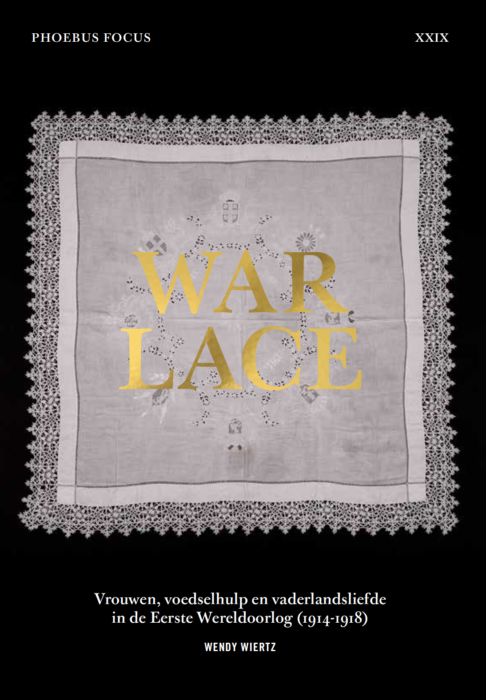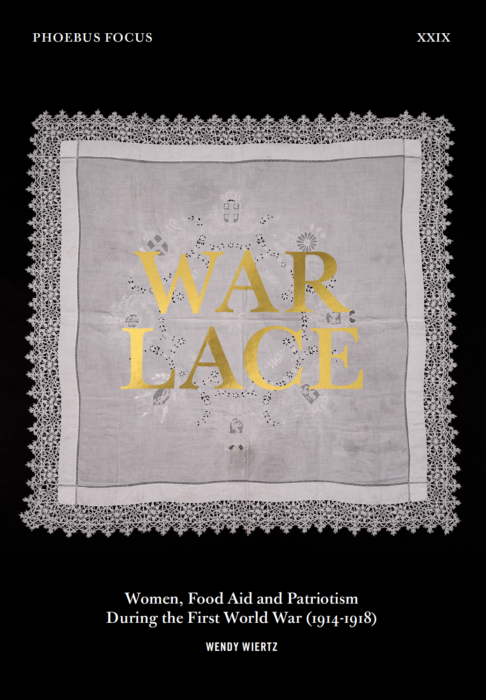
Phoebus Focus XXIX
Kant heeft een rijk en veelzijdig verleden, en werd door de eeuwen heen in diverse contexten gebruikt: bij rites de passage — doopsel, huwelijk en begrafenis — maar ook in oorlogstijd. De collectie van The Phoebus Foundation bevat een mooie deelverzameling oorlogskant, met stuk voor stuk lapjes kant met vaderlandslievende symbolen. Maar wie de ontwerpen van de stukken in de collectie van The Phoebus Foundation tekende en uitvoerde en wie dit oorlogskant precies kocht, kan niet meer worden achterhaald. Wel kunnen we dankzij deze war laces en ook dankzij archiefbronnen en publicaties het uitzonderlijke verhaal van de kantproductie in volle oorlogstijd reconstrueren.
Wendy Wiertz (°1985) is senior research fellow aan de University of Huddersfield.
Ze specialiseert zich in de materiële cultuur, genderstudies en humanitaire hulp van de negentiende en twintigste eeuw. In haar huidige onderzoeksproject, mogelijk gemaakt dankzij een Marie Skłodowska-Curie fellowship, focust ze op humanitaire organisaties die de vermaarde Belgische kantindustrie tijdens de Eerste Wereldoorlog hebben gered en tegelijk de werkgelegenheid voor kantwerksters verzekerden. Het geproduceerde kant raakte bekend als war lace (‘oorlogskant’), omdat de unieke iconografie ervan naar het conflict verwijst. Voorafgaand aan dit project behaalde ze een doctoraat in kunstwetenschappen (KU Leuven, 2018), was ze curator van de twee tentoonstellingen, namelijk Vrouwen met stijl. Vier penseelprinsessen in Hingene (Hingene, Kasteel d’Ursel, 2013) en Romantische landschappen. Marie de Flandre (Brussel, Koninklijk Paleis, 2015). Daarna was ze een Fulbright en ere-Belgian American Educational Foundation fellow aan Columbia University en een gastonderzoeker aan de University of Oxford.
- 21 x 14,8 cm
- 104 pagina's
- Softcover
- Quadrichromie
- Nederlandstalige editie
- ISBN 978 94 6436 653 2

Phoebus Focus XXIX
Lace has a rich and multifaceted past, and has been used in diverse contexts throughout the centuries: in rites of passage — christenings, weddings and funerals — as well as during times of war. The Phoebus Foundation’s collection includes a fine subcollection of pieces of war lace, all of them depicting patriotic symbols. However, it is now impossible to trace the individuals who drew and produced the designs of the pieces of war lace in The Phoebus Foundation’s collection, or those who bought them. Nonetheless, thanks to these examples of war lace, archive sources and publications, we can reconstruct the extraordinary story of the lace production that took place in the war.
Wendy Wiertz (b. 1985) is a senior research fellow at the University of Huddersfield.
Her research interests include material culture, gender studies and humanitarian aid in the nineteenth and twentieth centuries. In her current project, supported by a Marie Skłodowska-Curie fellowship, she focuses on humanitarian organisations that saved the renowned Belgian lace industry in the First World War while simultaneously ensuring the wartime employment of Belgian lacemakers. They produced what became known as war lace, after its unique iconography, which referred directly to the conflict. Prior to this project, she completed her PhD in Art History (KU Leuven, Belgium, 2018) and curated two exhibitions — Vrouwen met stijl. Vier penseelprinsessen in Hingene (Hingene, Kasteel d’Ursel, 2013) and Romantic Landscapes. Marie de Flandre (Brussels, Royal Palace, 2015) — after which she was a Fulbright and honorary Belgian American Educational Foundation scholar at Columbia University and an academic visitor at the University of Oxford.
- 21 x 14,8 cm
- 104 pagina's
- Softcover
- Quadrichromie
- Engelstalige editie
- ISBN 978 94 6436 656 3
Andere edities


